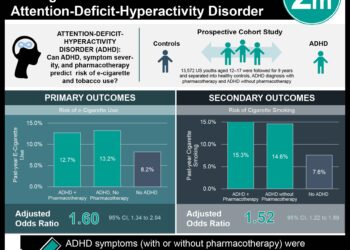The Scan by 2 Minute Medicine®: Powerful Phages, Vanishing Vaping, AirPods and the Ear, and Signs of Stroke:
07-09-2024
The Scan by 2 Minute Medicine® is a pop-culture medical newsletter and exclusive benefit for 2 Minute Medicine Plus subscribers.
We begin with a discussion about using viruses to kill bacteria. Then we take a closer at reductions in rates of teenage vaping across the US. After that, we examine the recent FDA approval of AirPods as hearing aids. Finally, we discuss Brian May’s recent stroke, and how to identify the signs of strokes.
Powerful Phages:
The Story: As it becomes more and more common to see antibiotic resistance, scientists need a solution. In Thea Turcotte’s case, this solution came in an uncommon way, it sounds unbelievable, but her life was saved by viruses.
What is a Virus?
While there are many types, a virus is a very general term used to describe a microbe that contains a basic set of genetic material, which requires the use of a cell to replicate and reproduce. As the virus replicates, it can eventually cause the host cell to rupture and spill out more viruses, which perpetuate the replication cycle again. Scientists are honing in on bacteriophages, a subclass of viruses that infect bacteria, as potential cures for drug-resistant organisms, which are becoming more and more plentiful.
Where do Bacteriophages fit in?
Bacteriophages are among the most abundant biological elements on Earth. They work similarly to other viruses, with the critical benefit of being extremely specific to bacteria. Given that each bacterial strain is very different, a single bacteriophage often only infects one strain of bacteria, making it the perfect solution to kill bacteria without harming human cells or beneficial bacteria in the body. They work by entering bacterial cells and hijacking their machinery to replicate more viral particles, until the cell bursts and releases the viral particles, where they will find another host to infect. With many examples of organisms across the globe that have become resistant to antibiotics, bacteriophages offer an innovative solution since these drug-resistant bacteria have never been exposed to bacteriophage therapy.
The Proof is in the Pudding:
For Thea Turcotte, there was no other choice. After suffering a severe joint infection and exhausting all antibiotic treatments to no avail, Turcotte was left with no other option. Fortunately, a sample of the bacteria causing the infection was used to make a custom bacteriophage designed to specifically infect and destroy that bacteria. Luckily, it worked. Turcotte has regained some ability to move around with a walker, something that did not appear possible initially. Turcotte isn’t the only one whose life has been renewed with the help of viruses. Dr. Steffanie Strathdee, in addition to studying infections, has personal experience with phage therapy. When her husband was losing the fight against the deadly superbug Acinetobacter baumannii, which was not responding to antibiotics, Dr. Strathdee implored scientists worldwide to search for phages to help. They struck gold. A cocktail of bacteriophages saved her husband’s life, and allowed him to recover from his coma.
Although this research is still developing, the future is bright for phage therapy. Not only is it potentially helpful for bacterial infections, some research is hinting at the possibility of engineering these phages for cancers. The world will stay tuned for the next updates in phage therapy.
Vanishing Vaping:
Down from nearly 10%, the teenage vaping rate in the USA has fallen under 6%, the lowest in 10 years. Although some may think that the reduction in vaping would coincide with an increase in other nicotine-containing products, fortunately, this was not the case. Although vaping is less harmful than smoking cigarettes, there are many harms to vaping, including the potential for addiction and increasing the risk of developing chronic lung disease.
The newest addition to an ever-evolving lineup of nicotine-containing products are nicotine pouches, designed to be placed in the gums and deliver nicotine through the mouth. While these pouches do not contain tobacco or as many chemicals as cigarettes, they are not risk-free either. These pouches may induce nausea, and cause damage to the gums and mouth, while also potentially changing the brain in a way that may negatively impact concentration, attention span, and learning.
Although this latest data is promising, there is more work to be done. An estimated 1.6 million teens are continuing to use e-cigarettes, and part of the reason may be due to celebrity endorsements. Some e-cigarette companies have begun using images of celebrities who may not even use their products, to advertise their products. It is very unlikely that Marilyn Monroe or John Lennon could even imagine an e-cigarette device, yet their images have been photoshopped to include e-cigarettes! Even with these aggressive marketing campaigns, teens are beginning to realize that risking their health by vaping isn’t cool, and if this trend continues, we’ll see more and more teens abandon their vapes, hopefully for less harmful alternatives.
Airpods and the Ear:
After decades of being known for producing phones, laptops, and other items, Apple is entering the medical device market. After receiving FDA approval, apple will be rolling out a new update to the Airpods Pro 2, allowing them to be used as hearing aids for individuals with mild to moderate hearing loss.
Hearing loss is a condition experienced by individuals that results in a reduced ability to hear sounds of certain frequencies. While typically associated with aging, hearing loss can occur for a variety of reasons, including exposure to loud sounds, infections of the ear, and mechanical damage resulting in the perforation of the eardrum. Generally, hearing loss is classified into 3 categories, conductive, sensorineural, or a mixture of both. Conductive hearing loss refers to an issue in the conduction of soundwaves from outside, to the inner ear. This may be the result of earwax, or issues affecting the eardrum. Sensorineural hearing loss refers to a condition that impairs the ability to transmit sound as a nerve impulse, while mixed hearing loss is a mixture of the two forms.
While there are many types, most hearing aids are typically helpful for sensorineural hearing loss. They work by amplifying sound waves through a microphone, and transmitting these amplified sounds into the ear so that the person hears the sound louder than they otherwise would.
Apple will offer a quick hearing test that can be done at home, and the results of this test will be used to determine which sounds an individual might need to amplify, which can be done with the AirPods. While hearing aids can cost upwards of $1,000, the AirPods Pro 2 offers a less expensive alternative, at $249, which will hopefully help individuals with mild to moderate hearing loss achieve satisfactory hearing, for a more affordable cost.
Signs of Stroke:
Brian May, known for his role as guitarist in the band, Queen, suffered a minor stroke which left him unable to play the guitar. After some time, May regained the ability to move his arm and can play the guitar, despite a list of other restrictions including not raising his heart rate too high.
It is estimated that in the USA, 1 person has a stroke every 40 minutes, resulting in almost 1 million individuals suffering from strokes annually. These insidious events can be life-threatening, as they are directly responsible for the death of brain tissue. Strokes occur due to a loss of blood flow in the brain, either due to a blood clot in an artery, or due to a severe bleed in the brain, which means blood cannot enter brain cells.
The symptoms of a stroke differ greatly depending on the area of the brain that loses blood flow. Often signs may include confusion, slurring of speech, one-sided weakness of the body, vision changes, or a loss of balance and coordination. The FAST acronym is used to check for suspected stroke, by asking the person to smile and observing for drooping of the face, raising the arms and observing for weakness in one, and observing for slurred speech. If these signs are observed, then the person should get medical attention immediately.
The extent of recovery depends heavily on how quickly a person is able to access treatment, since the longer the brain goes without blood, the more likely it is for tissue to die. It is thought that 8 American Presidents have suffered strokes, many with severe damage or even death. Strokes can also affect young, healthy individuals. Kris Letang, a veteran defenseman in the NHL, has suffered two strokes due to a congenital condition that has led to blood clots entering his brain. Fortunately for Letang, there are treatments for strokes, which look to break up the blood clots, or reduce the bleeding inside the brain, and with rapid treatment, Letang has been able to continue his successful career.
©2024 2 Minute Medicine, Inc. All rights reserved. No works may be reproduced without expressed written consent from 2 Minute Medicine, Inc. Inquire about licensing here. No article should be construed as medical advice and is not intended as such by the authors or by 2 Minute Medicine, Inc









